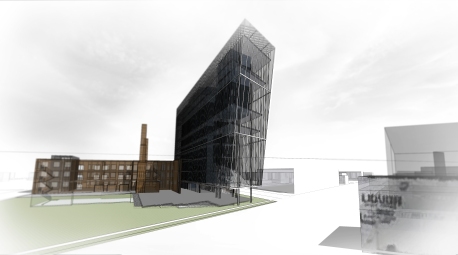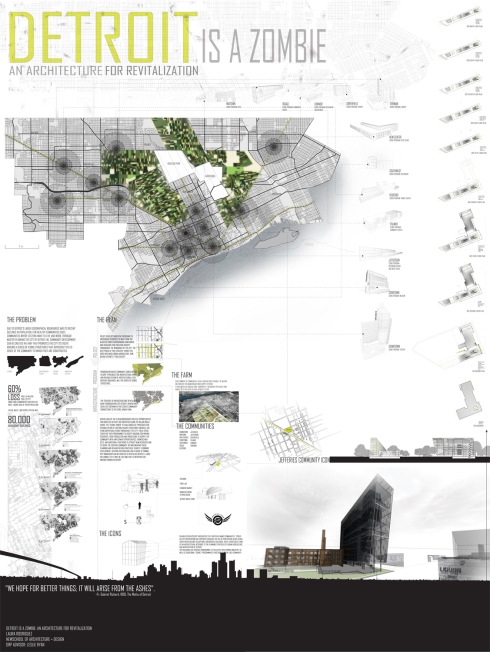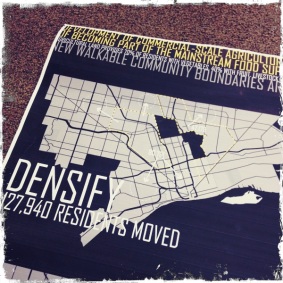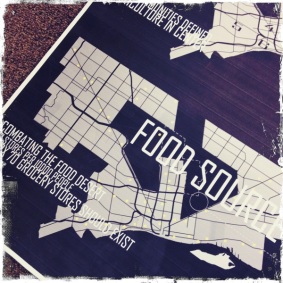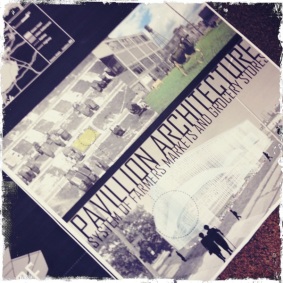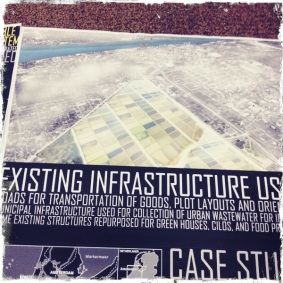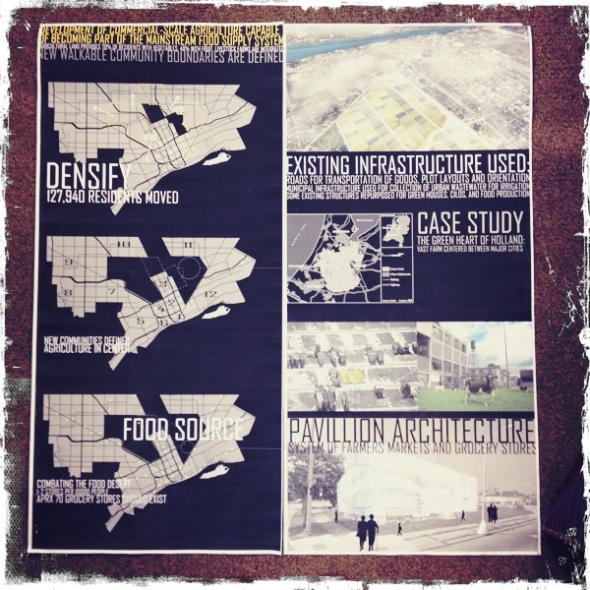Final Architectural Thesis Document
Final Architectural Thesis Document
Please click the above link to see my final thesis document regarding the revitalization of Detroit thru architecture and planning.
Thesising and The Zombie City
Newschool of Architecture and Design’s public relations manager, Anna Cearley, recently interviewed me about Detroit and the progress of my thesis. We talked about my project for quite a long time. I am not sure if she is putting together a press article for the school or if she is just gathering “thesis-Intel”, but I was pleased that she was interested in my project. She encouraged me to update my blog on the current state of my thesis and dare I say it, maybe even start a video blog on the subject. Is that a “Vlog”? I’m not sure… but I’ll definitely consider it! Reason being, not many people who do not live in or around Detroit are aware of its problems, outside of the occasional newspaper article about abandoned buildings, cars, corrupt city officials, or the impending “financial manager”. However, when talking about the city, I always mention the great things that I am aware of and love about Detroit; When the city comes alive at the start of April, AKA “April in the D”. St. Patrick’s Day when the city forgets its loss and the streets fill with enthusiastic youth partaking in green beer festivities. Events like the Downtown Hoedown, Detroit Electronic Music Festival, 4th of July at the Riverfront, any Tigers, Red Wings, or Lions game, Motown Winter Blast, concerts at the FOX and the Fillmore, during these events the emptiness dissolves and this dead city that the nation knows explodes with life. The city thrives in these moments because its people LIVE for these moments, when communities in and around the city unite for the gritty good of Detroit. If only the rest of the nation could see what I see! Change is possible through advocacy and awareness, and perhaps my little project, blog, or “vlog” could lend a hand in the process of much needed revitalization.
So now that I’ve rambled on, I should get back to business. I’ve not yet posted on the revised subject and rational of the project, so here that is:
Due to Detroit’s large geographical boundaries and its recent declines in population, few healthy communities exist; communities where citizens want to live and work. Through master planning the city of Detroit, MI, community development can be created in a way that promotes the city to evolve into series of iconic structures that represent the essence of the community to which it was constructed.
For a good portion of this quarter, I’ve been exploring some case studies regarding new urbanism, planning, and the “shrinking city”. A model that I’ve come to draw strategies from is Youngstown, OH and its Youngstown 2010 plan. The city, while it is much smaller in size than Detroit, essentially had the same problems of industry and population loss. Briefly, the Youngstown plan envisioned reshaping the city incrementally and voluntarily, and utilized tax incentive programs to move residents to healthier communities, leaving the leftover space for industrial businesses that needed the room.
For my initial planning process for Detroit, three different strategies were applied utilizing Policy, Program, and Infrastructure. Policy pushes the Youngstown model, and utilizes incentive programs to encourage residents to move from the areas of blight, which, when comparing demographic information, I found to be the core of the city surrounding Hamtramck, and Highland Park. By doing this, density is created throughout the remainder of the city. The next phase of the strategy is to use the now vacant core and create mass urban agriculture that combats Detroit’s “food desert” and feeds it’s residents. Program is a strategy to reshape community zones via freeway boundaries, creating walk-able, pedestrian friendly communities. This strategy would also identify the “missing pieces” of neighborhoods and develop typologies for architectural in-fill and branding of communities, aka, the series of iconic structures I mentioned earlier. The last planning strategy is Infrastructure, which through the aid of non-profit organizations, would work to revitalize the main thoroughfares of Detroit, specifically Grand River, Michigan Avenue, Fort Street, Woodward Avenue, Gratiot Avenue, and Jefferson. Creating a series of parks, schools, community centers, etc, that could build on the presence of the existing architecture and infrastructure and revitalize surrounding communities.
During my midterm reviews, the strategy of policy was strongly favored, however, some aspects of infrastructure and program can be applied when moving forward. Below are some photos of my midterm presentation. 
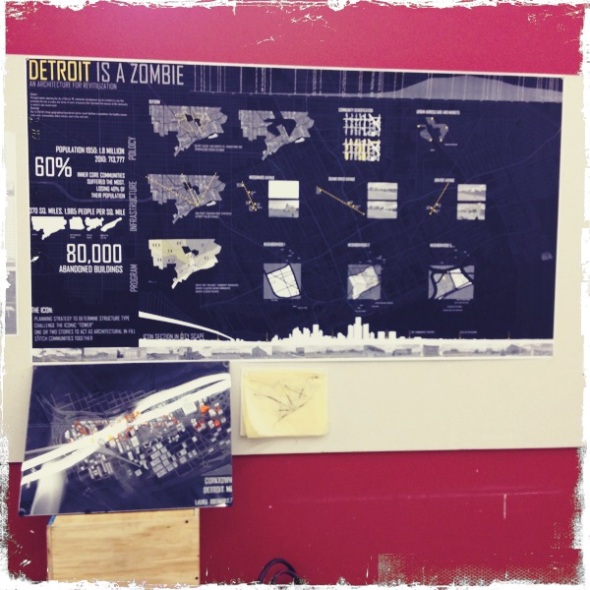
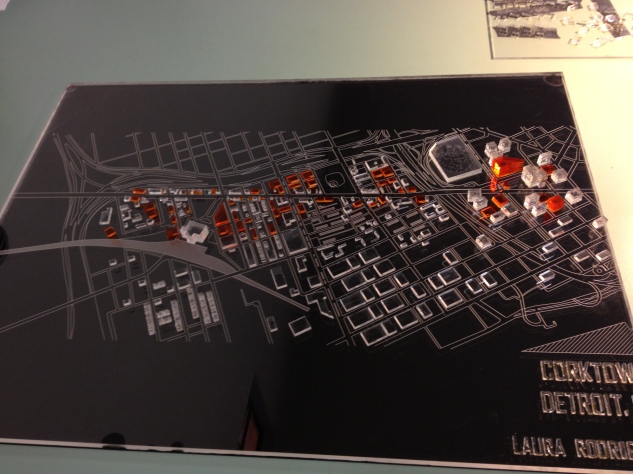

A model of Corktown, in which densification occurs along Michigan Avenue.
Moving forward from midterms, I’ve been working on the development of proper agricultural boundaries and exploring methods that incorporate existing infrastructure to support the farm system, perhaps rehabbing old factories as mills or factory farming for meat production.
So, a sustainable system of farming is created and could challenge the present food stamp and welfare model that exists in the city. Currently, there are very few grocery stores that exist in Detroit, AKA, the “food desert”, so those who are on the food stamp program must get their food from the surrounding convenient stores or fast food restaurants, hence the popular problem of skyrocketing obesity rates in the city. Recently, I read an article in the New York Times by David Firestone, in which he was touching on the subject of financial status of Detroit. In this article, he mentions community revitalization in the southwest side: “…newcomers from Mexico and other countries have revived several avenues with restaurants, groceries, and other stores. More diversity, more immigrants – that’s the key for the future…” (I plan on touching on the diversity issue in my project, but I’ll leave that for another day.) This article is one of many sources I could quote on the importance of food supply for healthy community development. This policy plan for agriculture could not only serve to make residents healthier, but also create a model of new urbanism; a city that is self-sustaining, who is no longer dependant on surrounding areas for food and goods.
Additionally, when moving residents from areas of blight, where do they go? I have been considering the role of my architectural response to this planning strategy, and perhaps the “iconic structures” that are created are ones that encompass elements of housing, food, and community centers. So, mixed use structures of farmers markets, housing, joining rec-centers or parks, and centers to provide education regarding health and integrating this locally grown produce into diets… the program possibilities for these structures are vast, and I believe that depending on where they are placed within each community, the program can vary.
I have some more data mapping that I have to do before I can move forward with test sites and analysis and dare I say it, test models for a building typology. I’m considering including some vacant structures in my designs for this building, and am excited at the possibility of incorporating Detroit’s existing architecture into this new building typology. As it is finals right now, I’m not sure how much of that I am going to be able to finish before then, but I still have next quarter to really dig into the structure.
Recently a student asked me, “so whats happening in Detroit?” My answer was, “what’s NOT happening?” Detroit has reached a time of incredible possibilities, and its often been said that Detroit could be the new model of urbanism when change happens; WHEN change happens. Unfortunately the circumstances of Detroit have led the rest of the nation to believe that the city is dead, but I’m here to say that through its people, Detroit is very much alive. A lurking zombie-city it may be, but one that is nevertheless moving toward recovery.
American Recovery and Reinvestment Act
While derelict buildings are common in Detroit, the city is actively engaged in reducing their numbers. One major funding source is the American Recovery and Reinvestment Act, which will be used to demolish more than 10,000 buildings by the end of current mayor Dave Bing’s term. Here, a collapsing building on the city’s east side is demarcated by city barriers before its soon-to-come demolition.
Human Scale
For the architect occupied with the tasks of urbanism, the measuring rod will be the human scale.
-Le Corbusier’s The Athens Charter.
After the downfall of the last hundred years, architecture must once again be placed in the service of man. It must lay sterile pomp aside, concern itself with the individual and create for his happiness the fixtures that will surround him, making all the movements of his life easier. Who can take the measures necessary to the accomplishment of this task if not the architect who possesses a complete awareness of man, who has abandoned illusory designs, and who, judiciously adapting the means to the desired ends, will create an order that bears within it a poetry of its own?
-Grossman. New York, NY: 1973
Unstoppable Matty
I’ve been trying to find a map or full list of Matty Maroun’s property holdings in Detroit, but so far have not had much luck. Here is some of the information I have found out:
Manuel “Matty” Maroun:
- Owns 625 parcels in Detroit, many purchased in Wayne County’s annual tax foreclosure sale for as little as $500
- Is the largest private-property owner in MI
- Is 83 years old
- Owns 400 vacant/dilapidated buildings, which are believed to discourage jobs and investments from coming to MI
- Owns the Ambassador Bridge, and is the only private owner of a border crossing between the U.S. and Canada
- Wants to build another bridge like the Ambassador and is suing to stop construction of the Detroit River International Crossing; a proposed publicly owned bridge
“You have to have a certain amount of grudging admiration for Matty Moroun, sort of like you do for crabgrass or those zombies in the low-budget horror flicks we used to watch as kids, when we should have been running around getting fresh air and exercise.
Matty takes a licking; has holes blown through him, is exposed and denounced, and he keeps staggering on, as only a true zombie can, toward the goal of twinning his Ambassador Bridge, or at least preventing a new, internationally owned one from being built.”
– Read more at http://www2.metrotimes.com/news/story.asp?id=14725
Talking about cities
“The second tier of US cities, such as Detroit, show how far, and how fast, cities can fall. Once nearly unimaginably wealthy, loaded with rapacious industrialists-cum-philanthropists, they have deteriorated into doughnuts: big, fat suburbs with a hallow core. These cores are inhabited by those who once powered the engines of industry and have become surplus to requirements, an urban generation abandoned. Welfare and fast-food dependent, they are the models of the unhealthy city.”
-Edwin Heathcote, “Cities of Hope: growing populations need new solutions”





